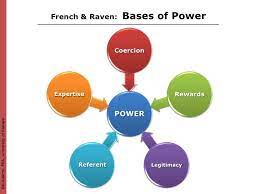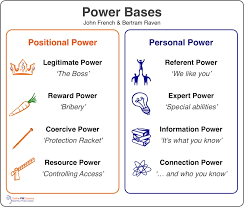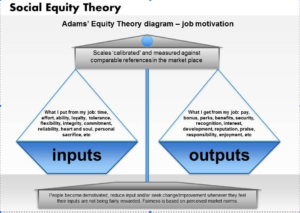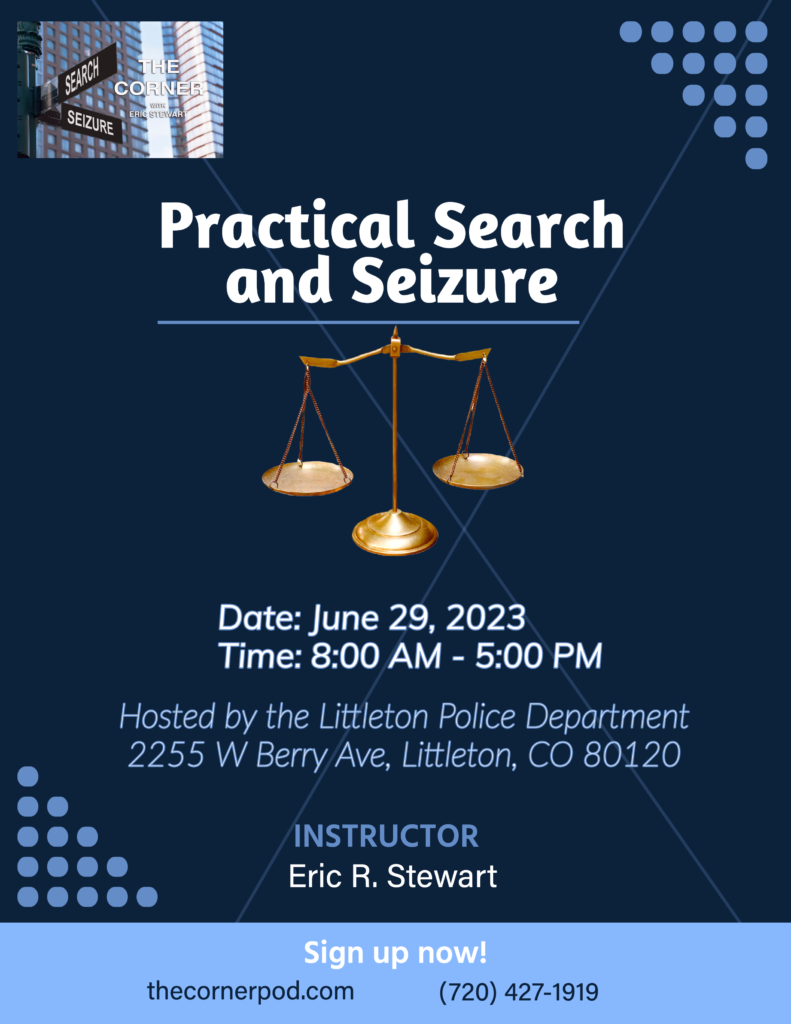THE CORNER POD: SEARCH AND SEIZURE TRAINING BULLETIN: EMERGENCY DOCTRINE
This installment of The Corner will tackle the “emergency aid doctrine.”
Bulletin Disclaimer:
I am not an attorney and make no claim to be an attorney. I developed this scenario/training bulletin based on my 38 years of law enforcement experience, my professional application of the Fourth Amendment (based on case law) in the field as a law enforcement officer, and my extensive study of case law pertaining to search and seizure.
I developed and am providing this training bulletin for information only. I make no claim that my interpretations and perceptions of case law provided in the answers to the scenarios are correct in any or all circumstances. All government agents and any other person gathering information from this presentation should consult their respective law enforcement agencies, City Attorney’s Office, District Attorney’s Office, State Attorney General’s Office, or United States Attorney’s Office for their interpretation and application of this information.
Scenario: You get a call regarding a welfare check. The notes in the call state that the employer of Joe Smith called and asked that police go to Joe’s residence to check on Joe’s welfare, because Joe failed to show up for work today (Monday), and Joe has never missed work in 30 years without calling in. According to Joe’s employer, Joe has not talked to anyone at work since Joe left work on Friday evening at 5:00 pm. You respond to Joe’s house, see that there are three newspapers (Saturday, Sunday, and Monday’s newspapers) lying on the porch (as if they were thrown there from the delivery person), and Joe’s car is in the driveway. You look around Joe’s house and don’t see any evidence of any problems (the doors and windows aren’t broken); however, you can smell a pretty strong and pungent odor (it smells like something is dead) coming through a slightly open bathroom window. Have you ever had a scenario similar to this? What did you do? What can you legally do?
The Fourth Amendment and the home
The Fourth Amendment stands on the premise that an individual’s home is his or her castle and that entry into an individual’s home by government officials, absent a warrant, in most circumstances, is unreasonable.
Exceptions to the warrant requirement; The United States Supreme Court’s three-step analysis for warrantless entries
There are, however, exceptions to the warrant requirement, one such exception being the emergency doctrine. The United States Supreme Court has never directly addressed the permissible scope of this exception; however, the Court has deemed such entries to be a variant of the exigent circumstances exception to the warrant requirement. Courts across the United States use the following three-step analysis to determine if a warrantless entry based on the emergency doctrine is acceptable: (1) whether the police had an objectively reasonable basis for believing there was an emergency, (2) whether the police action was motivated by a primary purpose to investigate or seize evidence, and (3) whether the scope and manner of the intrusion was reasonable under the circumstances. Two examples of United States Supreme Court decisions using the three-step analysis are Brigham City v. Stuart, 547 U.S. 398 (2006) and Michigan v. Fisher, 558 U.S. 45 (2009).
- Brigham City v. Stuart, 547 U.S. 398 (2006): Officers responded to a 3 a.m. call about a loud party. When officers arrived at the house in question, they heard shouting inside, proceeded down the driveway, and saw two juveniles drinking beer in the backyard. The officers entered the yard, and then saw, through a screen door and windows, an altercation in the kitchen between four adults and a juvenile, who punched one of the adults, causing him to spit blood in a sink. An officer opened the screen door and announced the officers’ presence. The officers arrested respondents and charged them with contributing to the delinquency of a minor and related offenses. The Court held that officers may enter a home without a warrant when they have an objectively reasonable basis for believing that an occupant is seriously injured or imminently threatened with such injury.
- Michigan v. Fisher, 558 U.S. 45 (2009): Officers responded to a residential disturbance and found three broken house windows, a truck with a smashed front end in the driveway, and damaged fence posts along the side of the property. Officers saw blood on the hood of the truck, on clothes inside of it, and on one of the doors to the house. Fisher was inside the house screaming and throwing things. Officers, seeing a cut on Fisher’s hand, asked Fisher if he needed medical attention. Fisher did not answer the question and instead told the officers to get a warrant. One of the officers entered the house and found Fisher pointing a gun at him. Fisher was ultimately arrested and charged with assault with a dangerous weapon and possession of a firearm during the commission of a felony. The United States Supreme Court found the entry into the house was justified by the emergency aid exception to the warrant requirement.
Application of the emergency doctrine in Colorado
Regarding the application of the emergency doctrine in Colorado, according to People v Amato, 193 Colo. 57; 562 P.2d 422; 1977 Colo. LEXIS 581:
The Colorado Supreme Court cited a list of factors relevant to the consideration of exigent circumstances which included (1) urgency; (2) time needed to get a warrant; (3) reasonable belief contraband would be removed or destroyed; and (4) possibility of danger to police guarding contraband while the warrant would be obtained…. In Colorado we have previously recognized the emergency doctrine but have not had cases which would justify its application. See Condon v. People, 176 Colo. 212, 489 P.2d 1297 (1971), and People v. Boorem, supra. Nevertheless, these cases leave no doubt that obtaining evidence or seizing contraband under the emergency doctrine must involve an immediate crisis and the probability that assistance will be helpful.
The Colorado Supreme Court cited several cases from other states and federal circuits when it decided the Amato case. One case the Colorado Supreme Court cited was State v. Sanders, 8 Wash. App. 306, 506 P.2d 892, 895 (1973). In this case, the court stated that it would only allow a warrantless entry into a residence based on an emergency doctrine exception “to render emergency aid and assistance to a person whom they reasonably believe to be in distress and in need of that assistance.” The court further stated that in order to justify the entry based on the emergency doctrine, “the officer must be able to point to specific and articulable facts which, taken together with rational inferences from those facts, reasonably warrant that intrusion.”
The 10th Circuit’s view on the community caretaker doctrine
There 10th Circuit has addressed warrantless entries into residences to render aid under what is referred to as the “community caretaker doctrine.” One such case, State v. Nemeth (New Mexico, 2001), involved officers responding to the residence of a reported suicidal party and upon arriving, the officers walked around the house, and knocked on the front door and windows of the residence several times, receiving no response. In addition, the officers observed that “the house was dark with no sign of activity inside.” The officers eventually saw someone looking at them from inside the house and made contact with the individual. The individual told the officers to leave; however, the officers, who observed the individual crying, did not leave, and eventually forced their way into the residence to contact the individual re: concern for the individual’s safety. Once inside with the individual, the officers were assaulted by the individual, and the individual was taken into custody and charged with Battery on a Police Officer. This case went to the New Mexico State Court of Appeals, which rendered the following thoughts and conclusion:
A response by law enforcement officers to a call seeking assistance in regard to a possible suicide inside a home can be characterized both as the rendering of emergency aid or assistance and the rendering of assistance out of a concern for a person’s safety and welfare. The activity falls within a more generic community caretaking function. The primary characteristic of community caretaking that sets this function apart from criminal investigative and enforcement activity is the absence of concern about violations of law on the part of the law enforcement officer. As long as the facts of a particular case meet the test for the community caretaking function that we set out below, that function can properly take its place in our jurisprudence as an exception to the Fourth Amendment warrant requirement.
Intrusion into a home acting in a community caretaker capacity is governed by the Fourth Amendment and its fundamental and underlying principle of reasonableness. The test of legitimacy under the community caretaker doctrine is whether the officers’ actions were objectively reasonable and in good faith. More particularly, the officer must have a reasonable and articulable belief, tested objectively, that a person is in need of immediate aid or assistance or protection from serious harm. See Carlson, 548 N.W.2d at 140-42; Commonwealth v. Waters, 456 S.E.2d 527, 530 (Va. Ct. App. 1995); Davis, 497 N.W.2d at 921…
The Fourth Amendment exception permitting warrantless entry into a home in the performance of community caretaking functions can be invoked only “when the police are not engaged in crime-solving activities.” Davis, 497 N.W.2d at 920. Furthermore, “the entry must be limited to the justification therefore, and the officer may not do more than is reasonably necessary to determine whether a person is in need of assistance, and to provide that assistance.” Id. at 921…
In denying Defendant’s motion to suppress, the trial court found that the officers had probable cause to enter Defendant’s home, that all of the surrounding circumstances supported the officers’ reasonable belief that Defendant was or might be suicidal, that none of those circumstances would dispel a reasonable person’s belief that Defendant was suicidal, and that the officers’ actions were reasonable. These determinations follow from the facts, and we see no basis to conclude that any is erroneous. While the court did not specifically mention the community caretaker doctrine in its order denying Defendant’s motion to suppress, we think that the court’s conclusion was completely consistent with and supported by that doctrine.
The officers’ actions constituted a check on the welfare of a person the officers reasonably believed to be in need of immediate assistance, and a reasonable, limited effort to determine if they could assist that person. This is a public service that fits squarely within a police officer’s community caretaking function. A warrantless entry into a home that passes the community caretaker test is an exception to the Fourth Amendment. Therefore, no warrant to enter Defendant’s home was required. The trial court here did not err in denying Defendant’s motion to suppress.
Limitations on warrantless entries in Colorado
Now, getting back to our scenario and whether you can legally enter Joe’s residence, in Condon v. People (1971), the Colorado Supreme Court found that officers responding to the call of a strong odor, possibly caused by a decomposing body, did not constitute an emergency justifying a warrantless entry into an apartment:
In Condon, the owner of a rental property discovered an odor like that of a decomposing body and called the police to investigate. The police came and searched the house without a warrant from top to bottom even though the odor was strongest in the basement. No body was ever discovered but the officers found drugs and boxes of chemicals suitable for making mescaline. We there held that the odor of a decomposing body did not constitute an emergency justifying a warrantless entry. The decaying odor was itself evidence assistance was no longer possible.
Using the court’s rationale pertaining to warrantless entries based on the emergency doctrine and the Condon case, which set a precedent in Colorado, law enforcement and fire personnel cannot make a warrantless entry into a residence to conduct a simple welfare check based on information that does not: (a) amount to an emergency, (b) involve an immediate crisis, or (c) amount to the probability that assistance will be helpful. Certainly, as the Condon case indicated, there is no immediate crisis and you cannot render aid to an individual that is already dead and decomposing.
Answer to the scenario
You are not legally allowed to enter the home without a warrant.
Implications of making a warrantless entry, safety concerns, and potential legal ramifications
Yes, I do understand that if you do make a warrantless entry into the home and find Joe dead, he cannot contest your entry (unless he is able to rise from the dead, but I only know of one person who has done this in the history of the world, so it is highly unlikely). However, if you find incriminating evidence that can be tied to someone else that does have standing, an expectation of privacy, and can contest the entry, the evidence, more than likely, can and will be suppressed. This could have implications if Joe had been murdered by someone that had standing in the house.
Additionally and possibly even more concerning than the above scenario are the potential legal and safety issues officers may face if they make a warrantless entry into a home without the requisite legal justification to do so and come face-to-face with the homeowner who has a gun in his hand. This scenario could have several tragic endings including the following: (1) the homeowner raises the gun and points it at officers who then fire their weapons and wound or kill the homeowner; and (2) the homeowner raises the gun to his head and shoots and kills himself. If either one of the above scenarios occurs, the officers and their Police Department will more than likely be sued for violating the homeowner’s Fourth Amendment rights and may face a wrongful death lawsuit. Regarding officer safety issues, another possible outcome is the homeowner shoots and wounds or kills an officer or multiple officers. In this tragic scenario, the surviving officers will potentially face legal ramifications for violating the homeowner’s Fourth Amendment rights and the homeowner may avoid prosecution for wounding or killing the officer(s).
Hopefully, this paper provides insight into and a better understanding of the nature and legality of warrantless entries based on the emergency doctrine. If you have any questions, comments, suggestions, etc., please contact me.
Be Safe,
Eric





